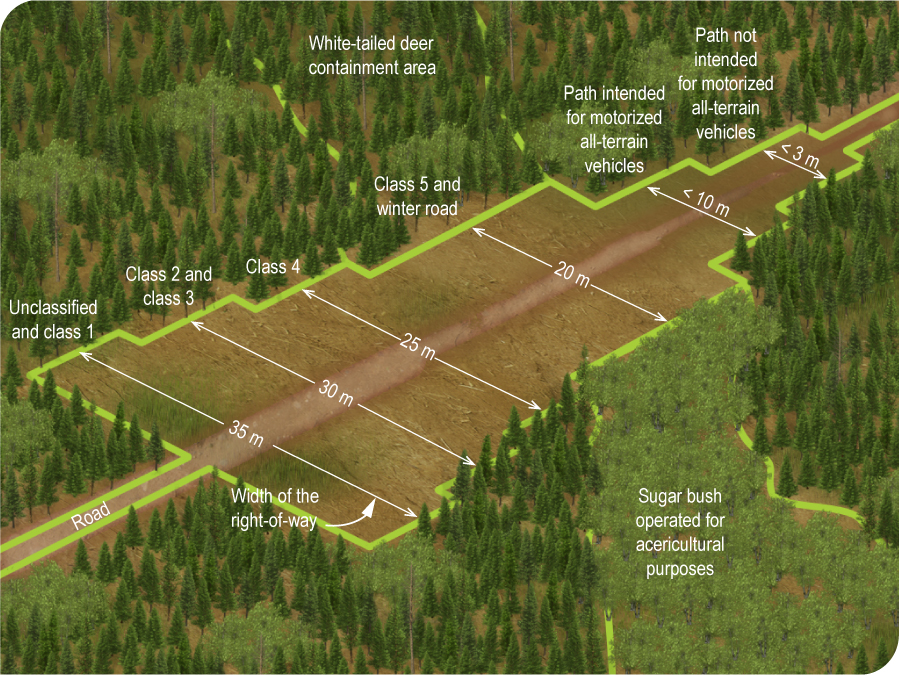Chapter V – Roads, sandpits and forest infrastructures
Division II – Roads
§3. Road implantation features
Section 71
Subject to the second paragraph, the width of the right-of-way of a road may not exceed the width prescribed in Schedule 4 for the class of road to which it belongs. For the purposes of this paragraph, the class of road is assessed on the basis of the width of the roadway and road shoulders, as indicated in Schedule 4.
The maximum width of the right-of-way of a road located within the limits of a sugar bush operated for acericultural purposes or having a potential for maple production or within the limits of a white-tailed deer yard is 20 m. For the purposes of this paragraph, a hardwood stand at least 60% of which is composed of sugar maples or red maples or a combination of both species and allowing more than 150 tapholes per hectare constitutes a sugar bush with a potential for maple production. The sugar bushes with a potential for maple production to be protected are those indicated in the numeric information layers used for forest planning. 
1
Objectives
- To reconcile the various activities that take place in the forest
- To preserve the integrity of a wildlife habitat
- To maintain the components of the forest cover that provide shelter for wildlife
- To maintain the components of the forest cover that provide food for wildlife
- To reduce loss of productive forest areas
Explanations
For road classes 1 to 5 and for unclassified roads, the maximum right-of-way width is established according to the width of the roadway and road shoulders. Refer to Schedule 4 for maximum right-of-way widths for these roads as well as for winter roads, trails intended for motorized all-terrain vehicles and trails intended for other activities. Other than right-of-way, roadway and shoulder width, all other characteristics given in Schedule 4 are for information only and are not provisions to observe in the application of this section.
It should be noted that the maximum width of the right-of-way corresponds to the maximum width that can be cleared for the roads and paths mentioned in Schedule 4. The maximum width of the right-of-way of all roads located inside the limits of a sugar bush operated for acericultural purposes, or with such production potential, or of a white-tailed deer containment area is 20 m.
Figure 71 Width of right-of-way by class of road
Additional information
A sugar bush operated for maple syrup production purposes is governed by a sugar bush management permit for acericultural purposes issued pursuant to the Sustainable Forest Development Act  .
.
This first paragraph does not apply to a person who, in accordance with section 41 of the Sustainable Forest Development Act  (chapter A-18.1), has been authorized by the Minister to build or improve a road whose right-of-way is wider than the width provided for in the first paragraph, nor to a person who has obtained such authorization under a forestry permit or a contract or agreement entered into under that Act.
(chapter A-18.1), has been authorized by the Minister to build or improve a road whose right-of-way is wider than the width provided for in the first paragraph, nor to a person who has obtained such authorization under a forestry permit or a contract or agreement entered into under that Act. 
2
Objective
- To protect forest resources during specific road, bridge or culvert construction or improvement work
Explanations
A person authorized by the Minister in accordance with section 41 of the Sustainable Forest Development Act  (chapter A-18.1) may construct or improve a road whose right-of-way is wider than the width provided in the first paragraph of section 71. The Minister may grant authorization and specify the conditions that must be met when carrying out the work.
(chapter A-18.1) may construct or improve a road whose right-of-way is wider than the width provided in the first paragraph of section 71. The Minister may grant authorization and specify the conditions that must be met when carrying out the work.
Additional information
A person wishing to obtain authorization must complete the following steps:
- Fill out the LADTF Section 41 Authorization Application Form
 ;
; - Have it signed by a forest engineer;
- Forward it to the management unit in the region
 (in French only) where the project is located.
(in French only) where the project is located.
He or she must describe the situation that justifies the work being carried out according to different standards from those set out in this Regulation. He or she must describe the situation that justifies the work being carried out according to different standards from those set out in this Regulation, for example, to enable the construction of a better quality road that is therefore more durable and safer. Where required, he or she must also provide alternative measures that would be implemented to achieve the objectives of the standards in the Regulation that are the subject of an exemption, for example, if the road is constructed or improved in a wildlife habitat other than a fish habitat, or if aquatic protection measures other than those set out in the Regulation are required. Where the proposed derogatory standards meet the approval framework, the authorization may be granted while specifying the conditions to be met in carrying out the work.
An authorization application for one or more projects per harvesting year may be completed if the authorization application is for an equivalent authorization for each road (e.g., authorization to construct or upgrade class 4, 5 and winter roads with a maximum right-of-way of 30 m) and that the roads are clearly identified in the application.

